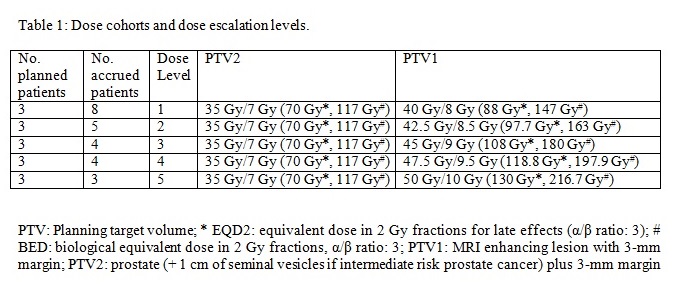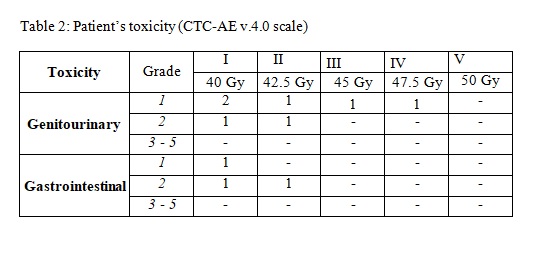SABR with boost to the DIL in low-intermediate risk prostate cancer: a dose escalation trial
MO-0218
Abstract
SABR with boost to the DIL in low-intermediate risk prostate cancer: a dose escalation trial
Authors: PAOLO BONOME1, Milena Ferro1, Gabriella Macchia1, Donato Pezzulla1, Carmela Romano2, Alice Zamagni3, Milly Buwenge3, Alessio Giuseppe Morganti3,4, Savino Cilla2, Francesco Deodato1,5
1Gemelli Molise Hospital - Università Cattolica del Sacro Cuore, Radiation Oncology Unit, Campobasso, Italy; 2Gemelli Molise Hospital - Università Cattolica del Sacro Cuore, Medical Physics Unit, Campobasso, Italy; 3IRCCS Azienda Ospedaliero-Universitaria di Bologna, Radiation Oncology, Bologna, Italy; 4Alma Mater Studiorum Bologna University, Department of Experimental, Diagnostic, and Specialty Medicine - DIMES, Bologna, Italy; 5Università Cattolica del Sacro Cuore, Istituto di Radiologia, Roma, Italy
Show Affiliations
Hide Affiliations
Purpose or Objective
To define the maximum tolerated dose (MTD) of stereotactic ablative radiotherapy (SABR) using Volumetric Modulated Arc with simultaneous integrated boost technique (VMAT-SIB) in prostate cancer patients treated with escalating doses to the dominant intraprostatic lesion (DIL).
Material and Methods
Low and intermediate – risk prostate carcinoma patients (NCCN risk classes) with American Urological Association (AUA) score ≤ 15 were enrolled in this phase I clinical trial. Rectal voiding, bladder filling and gold fiducials were mandatory for set-up. The prescribed dose to the prostate plus 3-mm margin (PTV2) was 35 Gy (7 Gy per fraction). To gradually increase total dose to the DIL identified by magnetic resonance imaging (MRI), the VMAT-SIB approach was applied. The MRI enhancing lesion with 3-mm margin (PTV1) received the dose escalation in five fractions (planned dose levels: 40, 42.5, 45, 47.5, 50Gy) (Table 1). The primary end point was to define the MTD considered as the dose-level below the one with dose limiting toxicity (DLT) recorded in at least one third of patients. Cohorts were expanded in the event of DLT. Dose-limiting toxicity was defined as any grade ≥ 3 gastrointestinal (GI) or genitourinary (GU) toxicity by Common Terminology Criteria of Adverse Events. All patients underwent rectal sigmoidoscopy 12 months after SABR and the Vienna Rectoscopy Score (VRS) was used to score the 1 year-late rectal toxicity outcome. Androgen deprivation therapy was associated to radiation treatment when clinically indicated.

Results
24 patients (median age: 75 years, range: 58-82) were enrolled between May 2014 and July 2021. All patients had cT2a-c N0 M0 clinical stage and/or a Gleason score of ≤ 7; 8 patients received 40 Gy, 5 patients 42.5Gy, 4 patients 45 Gy, 4 patients 47.5 Gy and 3 patients 50 Gy. Prostate volumes ranged from 28.9 to 101 cc, with a median DIL volumes of 4.6 cc (range 1.4-14.3). With a median follow-up of 26.3 months (range 8.9-84), no patients experienced dose-limiting toxicity (Table 2). Rectal bleeding (N=3), frequent urination (N=6) and urinary retention (N=1) were reported as late toxicity, none higher than grade 2. Sixteen of 24 (66.6%) patients had a 1-year VRS evaluation and grade 0, 1, 2, 3 were recorded in 3, 7, 4 and 2 patients, respectively. Thirteen of 24 patients (54.2%) underwent short course androgen deprivation therapy (3 months before and 3 months after SABR).

Conclusion
A SABR schedule of 35 Gy with a VMAT-SIB to the DIL up to 50 Gy in 5 fractions resulted to be a safe and feasible treatment in this setting.